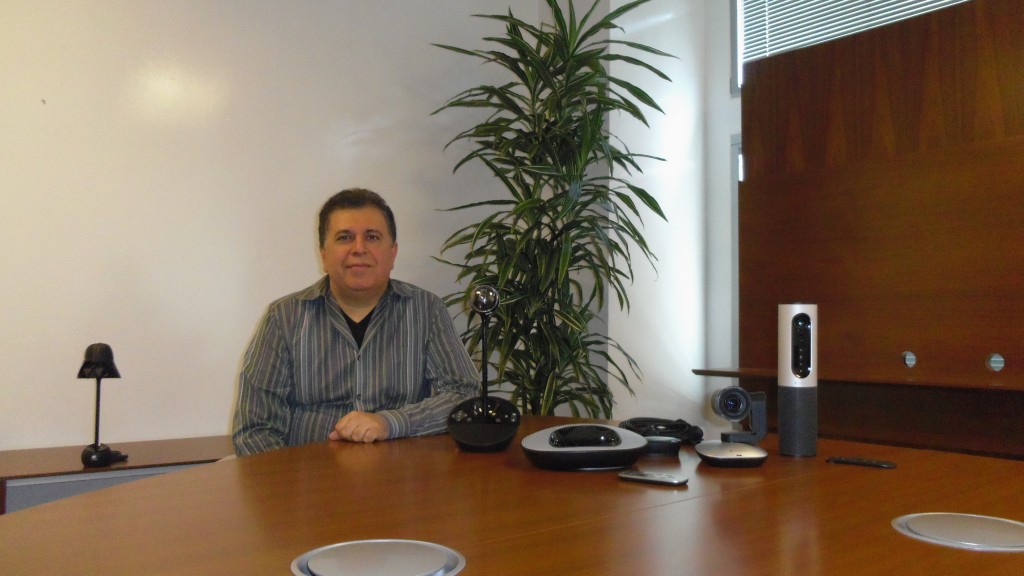
We recently spoke with our Senior Director of Engineering, Ali Moayer, the inventor of the ConferenceCam BCC950, the first integrated camera and speakerphone solution from Logitech, and had the opportunity to pick his brain on the motivations behind the camera as well as how it launched a whole new market segment. Here is what he had to say:
Q: What role does customer feedback play in how Logitech approaches R&D for new products?
Ali: Customer feedback informs innovation, and we learn about customer needs and challenges first hand whenever possible. They tell us about their interactions with our products and the possibilities they see for new ones. We probe and learn details of what really matters through their customer experience. This enables us to focus our design priorities on areas that can make a significant difference for the people who use our products in day-to-day, real-world settings.
Q: What specific customer feedback led to the development of ConferenceCam BCC950?
Ali: I learned about the challenges of deploying a videoconferencing session by trying to set one up with the separate audio and video equipment available at the time attached to a PC. The setup was complex and confusing. People had to learn how to select specific peripheral devices as well as setting them up for the proper configuration and functions. The launch of BCC950 solved these fundamental barriers by integrating audio and video into a single plug-and-play solution.
Q: ConferenceCam BCC950 is known as “Orbit Ali” internally at Logitech. What’s the back-story on that name?
Ali: I had an interest in building a PC peripheral product that integrated a speakerphone and a camera for several years. When discussing this idea with our management team, we needed a project name whenever we wanted to refer to this concept. The name “Orbit Ali” was chosen to refer to my proposal early in our product development discussion since I was integrating an older “Orbit” webcam module with a new speakerphone system. From there, we just kept this improvised project name throughout development and implementation of the product.
Q: ConferenceCam BCC950 was introduced in 2012. What was happening in the market at the time?
Ali: I think we started to see a faster adoption of Unified Communications in 2012. People were shifting their meeting communication tools from old telephony systems over to newer computer hardware and software-based solutions such as Microsoft® LyncTM , SkypeTM. ConferenceCam BCC950 was the only device available that could fulfill this need with an integrated camera and speakerphone. In fact, when we launched BCC950 that year, we were first to market with a product that established the ConferenceCam as a new market segment.
Q: What was most memorable for you about your first video call?
Ali: We were able to conduct my staff meeting with our team in Asia from my small office without having to book a busy conference room with large videoconferencing equipment. We were able to see everyone on both ends of the communication link with our wider-angle optics. It was particularly satisfying that the audio/video experience was on par with our videoconference room equipment.
Q: What did Logitech R&D learn from ConferenceCam BCC950 that has been applied to the newest product in the videoconference portfolio, ConferenceCam Connect?
Ali: While BCC950 was designed for small conference rooms and offices, people were buying this product and utilizing it in larger rooms. This prompted us to develop solutions for larger rooms in our new higher-end ConferenceCam offerings. We extended the audio system and optical zoom capability for people who were farther away from the camera and speakerphone. We also added Bluetooth® technology – a speakerphone link for smartphones and tablets, as people tend to utilize these personal devices with their favored communication tools.
Q: What’s ahead in the ConferenceCam R&D pipeline for the future? What new challenges are you focused on solving?
Ali: We are trying to lead by developing better cameras and speakerphones as well as helping the UC industry standardize on common interfaces for all personal computer and tablet platforms.
If you have any questions about our ConferenceCam lineup, ask away in the comments below!








